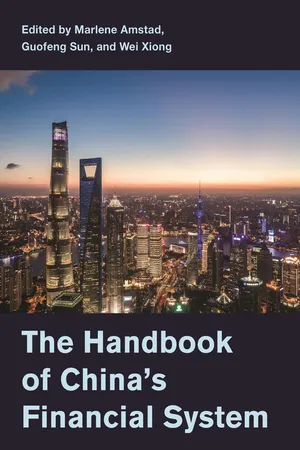
- English
- ePUB (mobile friendly)
- Available on iOS & Android
The Handbook of China's Financial System
About this book
A comprehensive, in-depth, and authoritative guide to China's financial system
The Chinese economy is one of the most important in the world, and its success is driven in large part by its financial system. Though closely scrutinized, this system is poorly understood and vastly different than those in the West. The Handbook of China's Financial System will serve as a standard reference guide and invaluable resource to the workings of this critical institution.
The handbook looks in depth at the central aspects of the system, including banking, bonds, the stock market, asset management, the pension system, and financial technology. Each chapter is written by leading experts in the field, and the contributors represent a unique mix of scholars and policymakers, many with firsthand knowledge of setting and carrying out Chinese financial policy. The first authoritative volume on China's financial system, this handbook sheds new light on how it developed, how it works, and the prospects and direction of significant reforms to come.
Contributors include Franklin Allen, Marlene Amstad, Kaiji Chen, Tuo Deng, Hanming Fang, Jin Feng, Tingting Ge, Kai Guo, Zhiguo He, Yiping Huang, Zhaojun Huang, Ningxin Jiang, Wenxi Jiang, Chang Liu, Jun Ma, Yanliang Mao, Fan Qi, Jun Qian, Chenyu Shan, Guofeng Sun, Xuan Tian, Chu Wang, Cong Wang, Tao Wang, Wei Xiong, Yi Xiong, Tao Zha, Bohui Zhang, Tianyu Zhang, Zhiwei Zhang, Ye Zhao, and Julie Lei Zhu.
Frequently asked questions
- Essential is ideal for learners and professionals who enjoy exploring a wide range of subjects. Access the Essential Library with 800,000+ trusted titles and best-sellers across business, personal growth, and the humanities. Includes unlimited reading time and Standard Read Aloud voice.
- Complete: Perfect for advanced learners and researchers needing full, unrestricted access. Unlock 1.4M+ books across hundreds of subjects, including academic and specialized titles. The Complete Plan also includes advanced features like Premium Read Aloud and Research Assistant.
Please note we cannot support devices running on iOS 13 and Android 7 or earlier. Learn more about using the app.
Information
PART 1
BANKING AND MONETARY POLICY
1
BANKING INSTITUTIONS AND BANKING REGULATIONS
1. INTRODUCTION
1.1. Banking Institutions Dominate China’s Financial System
Table of contents
- Cover Page
- Title Page
- Copyright Page
- Contents
- Foreword
- Introduction
- Part 1: Banking and Monetary Policy
- Part 2: Bond and Money Markets
- Part 3: Financial System and the Real Economy
- Part 4: Ongoing Reforms
- Part 5: Stock Market
- Part 6: Asset Management
- Part 7: Pension System
- Part 8: New Developments
- Editors and Contributors
- Index